#french review
Text
Nimona en bref
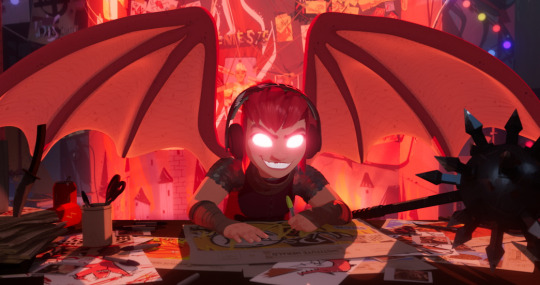
Il est de ces films dont le destin semble vouloir qu'ils sortent, quels que soient les chemins sinueux qui se dressent face à eux, et le nombre incalculable de fois où ils auraient pu disparaître.
Nimona, dernier petit bijou d'animation sorti sur Netflix, fait très clairement partie de ceux-là.
Sa production débute en 2015, suite à l'achat des droits du roman graphique de N.D Stevenson par le studio Blue Sky (mais si vous les connaissez, l'âge de glace, rio ou encore Snoopy le film). Objectif : une sortie en 2020.
C'est le début pour le studio d'un long et difficile voyage. À commencer par l'ambition du métrage, que Blue Sky voit comme un renouveau de son animation et de sa façon de raconter des récits, transition entamée par le film Snoopy. Mais les véritables problèmes arrivent en 2019, le studio se faisant racheter par Disney. Et là, ça coince, le nouveau grand patron n'apprécie pas la direction que prend l'œuvre, notamment sur un point précis : l'omniprésence du sujet LGBTQ+. Mais le studio se bat, en même temps difficiles de faire autrement, l'auteur de Nimona étant lui-même une personne transgenre.
Et que fait-on quand on n’arrive pas à censurer un projet et qu’on cherche à tout prix à ne pas perdre d’argent pour faire plaisir aux investisseurs ? On claque des doigts et on supprime bien sûr ! Et je n’exagère rien, puisque la compagnie aux grandes oreilles décide tout simplement de fermer Blue Sky, et d’annuler Nimona qui pourtant était déjà fini à plus de 70%. Le film termine donc son voyage en 2021, après avoir pourtant réussi à résister à un changement de réalisateur et au Covid.
C’est ce que l’on pensait tous avec tristesse, avant d’apprendre en avril 2022 que le projet serait bel et bien terminé, repris par Annapurna Pictures et sa nouvelle branche animation (chapeauté par d’anciens de Blue Sky, tient tient…). Et quelle surprise de voir le nom de Netflix apparaître pour sa diffusion internationale ! Ça y est, le film est sauvé.
Pour quel résultat ? C'est ce qu'on va voir
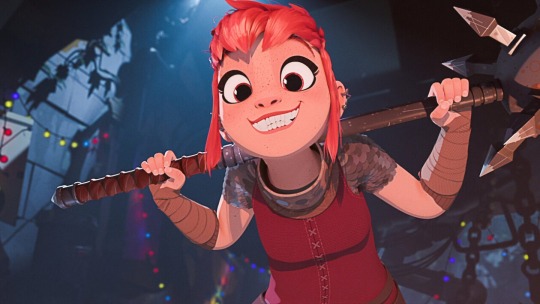
Bon, je commencerai en parlant des points faibles du métrage, car il y en a. Sa structure narrative est très simple, et l'histoire au globale est prévisible. Sans être mauvaise, elle suit son cours sans jamais réellement nous surprendre. Les retournements de situation sont attendus, et ce n'est pas par là que brille le film. En somme, de l'efficacité avant l'originalité. Mais ce n'est pas dérangeant pour autant.
Une originalité qui par contre est omniprésente dans ses visuels.
L'univers présenté est déjà très beau et original. Il nous offre un univers médiéval futuriste très soigné et stylisé, rappelant évidemment des œuvres comme Blade Runner, mais aussi des mondes comme Overwatch ou technologie de pointe et traditions ancestrales se mêlent. Le tout forme un monde très attrayant, bien qu'assez peu approfondi.
À cette proposition s'ajoute un style graphique très singulier et atypique, en 3D stylisée. Et contrairement aux autres œuvres dont on a pu entendre parler récemment, il est bon de pouvoir dire, pour une fois, que Nimona n’est pas inspiré ou influencé par Into the spider-verse. C’est intéressant de voir que plusieurs œuvres ont pris des chemins similaires à des périodes très proches, dans leur façon de renouveler leur animation, et que Spider-verse n’est pas le seul à avoir tenté cette approche.
Le style est ici maîtrisé et vraiment beau, utilisant des formes géométriques très marquées pour la création de son univers et ses personnages, ce qui lui donne une texture unique. Les lumières et couleurs se distinguent aussi. À de très nombreux moments, il y a des palettes très franches, avec souvent une couleur dominante qui va s’étaler sur toute la scène. Une particularité qui vient du fait qu’une grande partie du récit se passe dans des lieux sombre, ou en intérieur, éclairés par des lumières artificielles et des néons. Dans la suite de cette idée, les jeux de contrastes sont assez importants et récurrents. Des couleurs qui ont un rôle important puisqu’elles sont utilisées à de nombreuses reprises pour représenter à l’image les sentiments entre les personnages, leurs évolutions, et quelle est la dynamique en cours.
L’animation en elle-même est fluide et agréable à regarder, même si j’ai quelques réserves sur certaines scènes. Les moments d’actions notamment, qui selon moi manque dans la réalisation d’un peu de percutant et d’intensité. Rien de bien terrible, mais on sent vers quoi les réal voulaient tendres, sans parvenir à l’atteindre totalement. Mais elles restent très agréables, et ne sont de toute façon pas ce sur quoi repose le film.
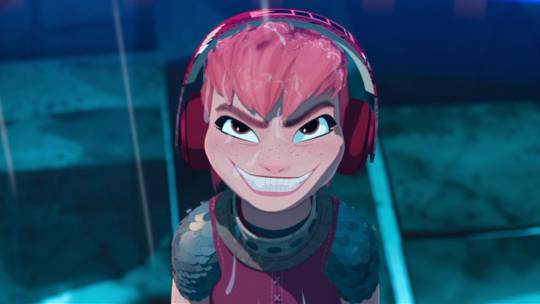
Car ce qui selon moi porte le film, au-delà de cet univers, ce sont ses personnages. Crédibles, attachants, bien écrits, ils nous donnent envie de les suivre et de continuer le récit avec eux. L’évidence étant la parfaite réussite qu’est Nimona. Le personnage est constamment plein de vie, d’énergie, et ne tient pas en place. Et cet état d’esprit est accompagné par un soin tout particulier à son animation. Sa gestuelle, ses mouvements, ses expressions faciales, tout est cartoonesque et les animateurs n’hésitent pas à exagérer ou déformer le personnage pour accentuer une émotion ou une expression. Nimona en devient fascinante à regarder, un petit bonbon d’animation, auquel s’ajoute un charadesign parfait.
Mais les scènes touchantes ne manquent pas, et son personnage ne se limite ainsi pas à un simple sidekick humoristique constamment dans la surréaction. Le contraste avec son habituelle vitalité rend ces scènes d’autant plus touchantes et prenantes.
Le film se permet même en fin de récit d’aborder frontalement des thématiques très sombres comme le suicide.
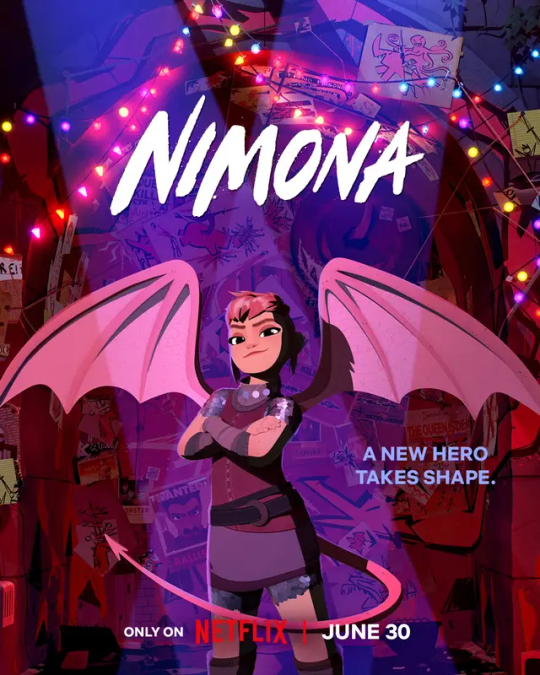
Je trouve aussi très important et agréable le fait que le film aborde aussi bien les problématiques LGBTQ+, et ce, de manière subtile. Si je parle de subtilité ici, ce n’est pas en termes de discrétion. Oui, les thématiques sont bien visibles, les sous-textes très évidents. Mais pour autant, la manière dont elles sont traitées permet de raisonner aussi avec des personnes extérieures à cette communauté. Ça n'exclut personne, le message est à la fois très ciblé, mais aussi très accessible et généraliste.
Les personnages ne sont pas des stéréotypes définis uniquement par leur sexualité, et ne sont pas présents que pour pouvoir dire "regardez on est progressistes, on a mis des gays".
Et il serait possible de creuser le sujet pendant des heures, tant le nombre de sous textes est important. Un message qui ne passe pas uniquement par les dialogues, c’est ce qui est aussi intéressant. La réalisation, l’utilisation des lumières et de nombreuses scènes ou séquences sont pensées pour pouvoir être vues à travers le prisme de ces problématiques. J’ai personnellement trouvé très intéressant de repenser certaines scènes et d’avoir ce petit “Aaah oui ça peut être vu comme ça” en tête.
Ce sous-texte met aussi en évidence les horribles situations dans lesquelles se retrouvent ce genre de personnes. Une réalité qui est malheureusement encore et toujours d'actualité. Et c'est aussi ce qui rend le film intéressant car il aborde frontalement ces thématiques très graves et pesantes, et ne tente pas d'embellir la situation pour plaire à un public plus large.
Et n'en déplaise aux puristes, je l'ai regardé en VF, qui est d'une excellente qualité de bout en bout, sans aucune fausse note, et permet de profiter un peu mieux des visuels qui nous sont proposés.
Petit dernier point sur la musique, qui n'est ici pas excellente. Elle a tout de même pour elle de proposer des orchestrations assez différentes tout au long du film, entre des morceaux épurés à la guitare, du rock/métal, de l'électro... Une musique qui accompagne bien le film mais qui pour moi, en dehors d'un ou deux thèmes, ne me marquera pas plus que ça.
Mais bref, tout ça pour vous dire de vous jeter sur ce film. C’est bien fait, frais, et avec un message important très bien amené. Le tout enrobé dans un délice visuel d’animation et de couleur.
2 notes
·
View notes
Text
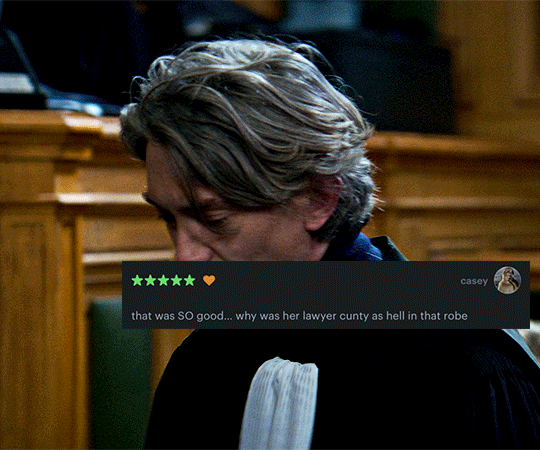

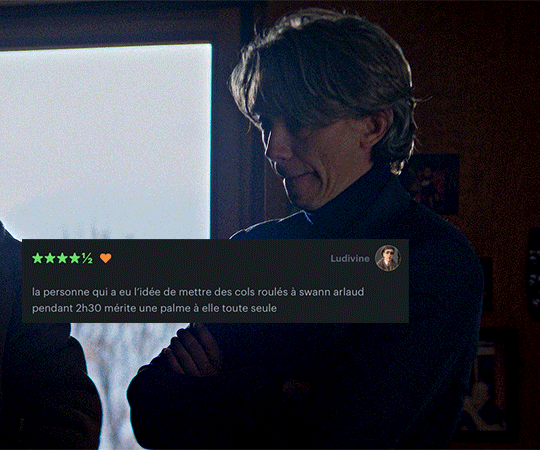
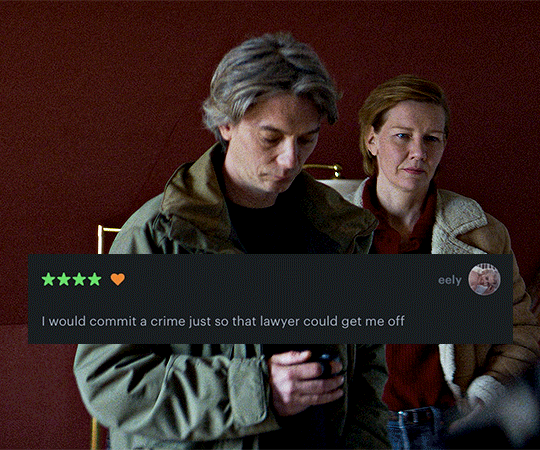
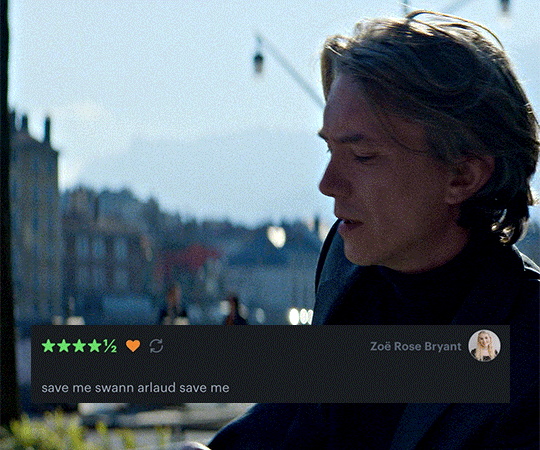
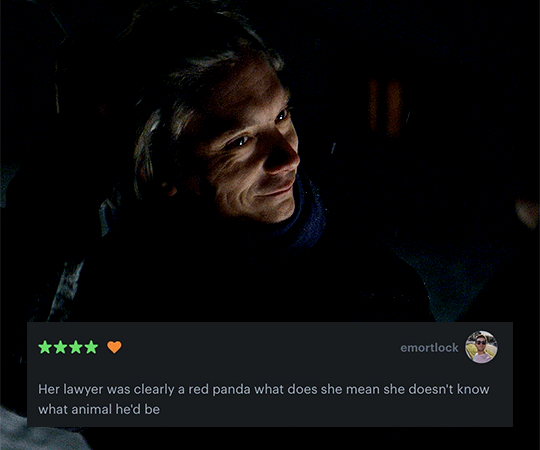
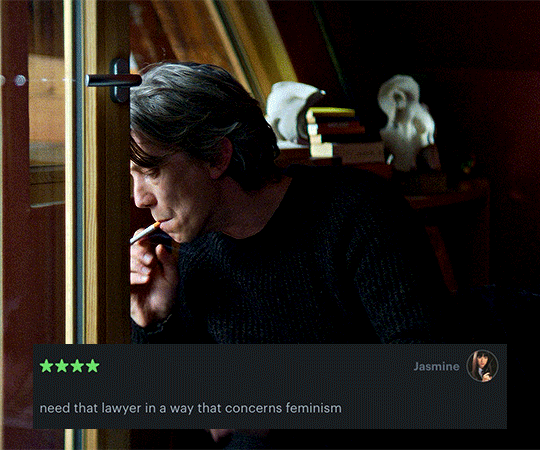
SWANN ARLAUD + LETTERBOXD REVIEWS
Anatomy of a Fall (2023)
#anatomy of a fall#anatomie d'une chute#swann arlaud#vincent renzi#filmedit#flawlessgentlemen#dilfgifs#dilfsource#*#me: this man better not awake something in me#my brain giggling: oh baby girl you are in for a ride#i am SO mad at myself. i'm so predicable sometimes#the review in french says: whoever decided to put swann arlaud in a turtleneck for 2h30 deserves an award by itself
2K notes
·
View notes
Photo

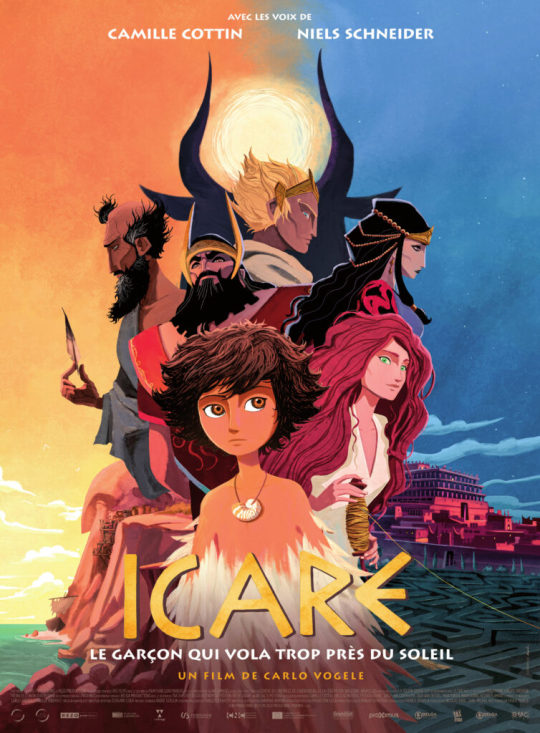
So there was a french animated film about the friendship between Icarus and the Minotaur last year and I was supposed to hear about it on the bird app?
I mean it’s literally not streaming anywhere yet nor does it have a home media release at this time but I would like to get hyped in hopes of one of those things happening eventually.


It has a good style! I would like to see the tragedy!
#icarus#the minotaur#minotaur#asterion#king minos#french film#movie#icare#theseus#ariane#the reviews are fairly mid and i do not care#let. them. be. friends.#greek mythology#if they're both doomed by the narrative then let them serve their time together
5K notes
·
View notes
Text
L’énigme de la chambre 622 - Joël Dicker
“La vie, comme un roman, doit être une aventure.”
J’ai lu pratiquement tous les romans de Joël Dicker, mais à chaque nouvel opus, je suis de plus en plus réticente à la lecture. La raison ? J’avais été très déçue par La disparition de Stephanie Mailer, qui n’avait aucun intérêt pour moi, et depuis, je crains d’être confrontée à un nouvel échec de lecture. J’ai tenté le tout pour le tour avec L’énigme de la chambre 622 que je me suis offert avec une carte cadeau - je me disais ainsi que je culpabiliserais moins si, in fine, le roman ne me plaisait pas...

Qu’est-ce que ça raconte ?
Une nuit de décembre, un meurtre a lieu au Palace de Verbier, dans les Alpes suisses. L’enquête de police n’aboutira jamais. Des années plus tard, au début de l’été 2018, lorsqu’un écrivain se rend dans ce même hôtel pour y passer des vacances, il est loin d’imaginer qu’il va se retrouver plongé dans cette affaire. Que s’est-il passé dans la chambre 622 du Palace de Verbier ?
Est-ce que je suis totalement réconciliée avec Joël Dicker ? Pas tout à fait. Je continue de lui trouver des imperfections que je ne détectais pas forcément dans ses premiers romans : des personnages caricaturaux, des schémas redondants, des remarques qui tombent comme un cheveu sur la soupe, des dialogues assez vides, et des dénouements totalement rocambolesques et invraisemblables. L’énigme de la chambre 622 était certes un bon page-turner, qui se lisait avec facilité; mais les clichés de banquiers suisses assoiffés de fortune et de réussite, de jeunes génies à qui tout réussit sauf l’amour, les séparations tragiques entre âmes sœurs qui se retrouvent plus tard, les révélations totalement absurdes, les déguisements, les masques qui tombent en manquant parfois de cohérence et de réalisme, une riche héritière, un roman dans le roman...Pour moi, c’était un peu trop. La lecture n’était pas désagréable pour autant, mais je n’ai pas été absolument entraînée par le suspense, et je n’ai pas été comblée par les solutions offertes par l’auteur. Des lecteurs appréciant les retournements de situation, les rebondissements par dizaines, et les révélations au compte-goutte y trouveront peut-être leur compte.
Est-ce bien grave ? Non, parce que j’ai par ailleurs accepté l’idée que j’ai préféré les récits rythmés par la présence de Marcus Goodman et qu’en son absence, il m’allait être difficile d’apprécier autant les enquêtes de Dicker. J’ai lu tous les Joël Dicker sortis à date, et je n’ai rien aimé tant que La vérité sur l’affaire Harry Quebert et Le livre des Baltimore. J’avais même beaucoup apprécié ce deuxième opus et ces nouveaux personnages, comme Hillel. Est-ce par la faute de Marcus seul ou par tout l’univers construit par l’auteur autour de ce protagoniste auquel il s’identifie en créant toutefois une nouvelle personnalité ? Aujourd’hui, je me suis fait une raison, et avant même d’entamer un nouveau roman de l’auteur suisse, je me prépare à ne pas succomber immédiatement et à ne pas tomber sous le charme comme pour Harry Quebert. Ce n’est pas une fatalité en soi, et ça ne me gâche pas le plaisir de lire un roman policier; j’appréhende juste le livre désormais avec une approche plus adaptée au plaisir qui en découlera.
Est-ce que je reconnais la vertu thérapeutique de ce roman pour son auteur qui faisait ses adieux en beauté à son éditeur et ami ? Inévitablement. J’ai parfois trouvé gênantes dans le rythme de lecture et lourdes les nombreuses références à Bernard de Fallois, à travers lesquelles on sentait Joël Dicker évoquer ses souvenirs avec transparence, honnêteté et intimité; mais il est difficile de reprocher à un auteur de vouloir rendre hommage à celui qui l’a découvert, qui l’a fait grandir et lui a tout appris. Je trouve cela juste dommage que ces éléments n’aient pas été insérées de façon plus naturelle dans le récit, parce que chaque souvenir évoqué à propos de Bernard causait pour moi une rupture forte dans le rythme de l’histoire, à tel point qu’il était difficile de se remettre dans la dynamique de l’enquête ensuite. Un autre élément qui m’a beaucoup gênée dans cette perspective d’introduire le réel dans la fiction et de faire tomber le quatrième mur, c’est cette tendance à s’autoproclamer l’Écrivain, et à se jeter des fleurs et à rappeler son succès tous les dix pages. Seigneur, qu’il était satisfait de quitter la temporalité de l’Écrivain, cela permettait d’être épargné pendant plusieurs chapitres des remarques pompeuses de Joël Dicker sur son propre succès dont il aime visiblement beaucoup parler à la troisième personne en se cachant derrière un alter ego littéraire.
Ainsi, L’énigme de la chambre 622 n’était pas un coup de cœur pour moi, mais ce roman reste un page-turner accessible quand on ne veut pas se prendre la tête à lire un policier compliqué - quoiqu’on s’y perd parfois un peu.
Vous voulez l’acheter ? J’ai profité d’une carte cadeau pour commander ce roman à la Fnac pour 9,50€. Vous pouvez le trouver facilement en librairie, chez des bouquinistes ou en revente; ou le commander auprès de votre libraire préféré.
#polar#book lover#book addict#book worm#book review#bookreview#book shelf#book tumblr#joel dicker#french review
0 notes
Text
So I'm sure everybody cares but I went to see "le comte of Monte Cristo " (the last adaptation with Niney) and got out of the theater with a splitting headache but absolutely amazed and admiring.
I am a big reader and read a lot of Alexandre Dumas (including Monte Cristo a long time ago) and other dramas and "sad" books but I always was reluctant to see real dramas with ambiguous or sad endings. The only reason I went to see the movie was bc I liked the book.
The movie is in fact harsh, sad and VERY dramatic (like the book) but it is extremely well realised. All of the actors play extremely well and the length to wich Niney went to prepare for the role shows trough the screen.
I was so enthralled by the movie I forgot to eat my popcorn. The movie manages to create an atmosphere like a bubble, and despite not managing to remember very well the book , I did feel IN the book, taken by the story as I had read it.
Yeah so in short, go spend 3h in a theater to watch this film, it's worth it
#alexandre dumas#le comte de monte cristo#pierre niney#the count of monte cristo#Monte Cristo#film review#Who will hyperfixate on the books again and finish them all in three days ?#Because the movie messed with their heads and they can't remember shit about the book now#french movie
65 notes
·
View notes
Text

you can actually see the thoughts going through his head: "zis focking shit zis BULLSHIT book full of LIES what ze fuck, fuck louis, fuck our love, fuck arman, fuck claudia, fuck the fucking zord, fuck me, i shall zet a BIG FIRE and put zis abomination down your throat monsieur zeniel, fuck you"
#this man hates this book#he is full of contempt#there has never been a more contemptuous man#he gives a 2/10 review to any one that may ask#lestat de lioncourt#armand de romanus#daniel molloy#louis de pointe du lac#loustat#the invisible chord#claudia de lioncourt#interview with the vampire#iwtv#iwtv s2#iwtv s3#iwtv s3 teaser#amc iwtv#anne rice's interview with the vampire#i do not know french accents they all speak the z language to me
110 notes
·
View notes
Text


All he had were: his own past, which was so short; his present - so sombre; and his future - so uncertain: nineteen years of light to contemplate, in what might be eternal darkness!
#reading#books read in 2024#bookblr#books#book photography#book blog#bibliophile#books reading#books and reading#count of monte cristo#the count of monte cristo#monte cristo#edmond dantes#alexandre dumas#dumas#classic literature#classics#classic#french#french classics#long books#revenge#innocence#payback#payback is sweet#this felt so long#satisfying ending#review#four stars#june reads
86 notes
·
View notes
Text
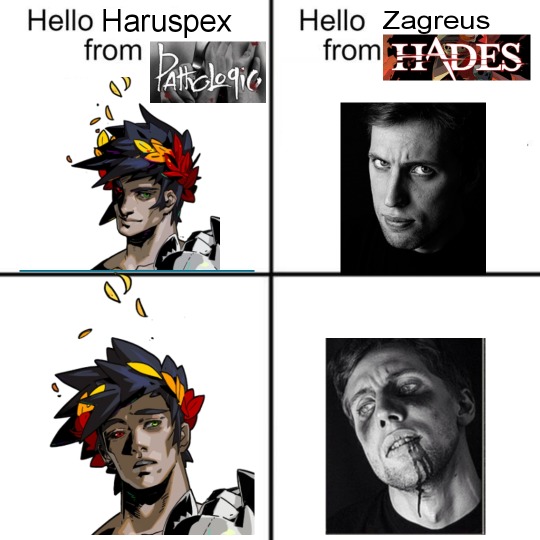
do u understand
#sorry i have not know peace since i found out about the injured healer portraits.#i can only find artemys online if anyone else is aware of the others PLEASE LMK begging sobbing#shout out to whichever french gaming review website posted the screengrab idk if they had early access or what but i cannot find them#early access in 2005 lol#pathologic#hades game#artemy burakh#zagreus#ok enough tags i prommy
226 notes
·
View notes
Text
Circles of Heaven
Circles of Heaven, Eustace Selden, 1998
Circles of Heaven (CoH) started off as a hard rebound against the Satanic Panic - by an evangelical kid. The goal was to make an RPG that would be considered holy. This... did not happen.
The author did his first writing when he was 14, which beats me by a year. Unlike me, he was raised in... well, a cult. The first version of CoH was about playing angels, but it was also full of proto-quiverfull eschatological heaven-justifies-the-means propaganda. By the time he was 17, his friends had successfully pulled him out of the cult and gotten him living with distant relatives in Tacoma. The author's changing worldview, the evolving music scene, some bootleg anime, and suggestions from the same friends - seriously, this friend group is fantastic - led to a major revision of the game. It was published locally in 1998, printed by a local shop and driven around to game stores and bookstores until they found some that would sell it.
Chargen is mostly random. You pick your Nobility and Corpus. Nobility is your rank, which doesn't let you order each other around but does apply to certain creatures. For example, Archdukes can give orders to insects; a Prince or Princess of Heaven can give orders to mammals (except humans). You get some alliterative skills related to your type of creature - Archdukes get bonuses to Clandestine, Collective, and Contaminate.
Corpus is your body, and I think it's a particularly fun part of the game. Characters in CoH are angels. They're not traditional biblical angels, because the bible is secretly the work of Satan - full of half-truths more dangerous than outright lies. Instead, they're inspired by the weirdest of monsters: adlets, nuckelavee, ouroboros, futakuchi-onna, penanggalan, and a several others. You are both a human being and your monster self at the same time. You can do things that either form could do, or even things that would need both a monster and a human in the same place at the same time, and it doesn't have to make sense to see.
You roll for your Hunt (the kind of people you're here on Earth to help or punish, gives skill bonuses), your Time (the hour each day where you have extra-special powers), your Vision (how you think the world could be made ideal, gives you more skill bonuses), and your Ruling Virtues. Oh, and your attributes. Those are done on a 5-15 scale generated from a d100 table. I did say this game was written in the early 90s.
You also roll for your equipment. Not boring mortal stuff, but for a wide variety of sacred items that you hold in potentia near you and can manifest at need. Shields of fire. Shadow citadels that can hide you overnight. Flocks of stained-glass butterflies that provide cover and distracting fascination. Daybreak, the mace made of pure sunlight. Nullblades that wield themselves and absorb bullets and magic alike. Fatehook, a crochet hook that can re-knot the fabric of the world - slow to use but flexible and devastating.
The system is mediocre. It's basically a heavily-stripped-down Rolemaster, with no critical hits or spell lists. If you can't come up with anything from Rolemaster that isn't the critical hits table, you're not alone. CoH's system sort of slid into my brain and slid right back out without making an impression.
The place the game is really lacking is art. Most of it is from early otaku who loved anime but had never taken an art class. The best of it turned out to be traced from manga. The cover was a black-and-white ouroboros on a white background, which, while still not particularly well-drawn, was at least striking on the shelf.
Eustace eventually moved on. In an interview in 2012 he said that writing the game was a cathartic experience for him, helping him understand where he came from and embrace where he was going. Once it was out, he didn't feel the need to keep writing. I hope he finds a creative spark again some day - I think a shorter version (with better art) would fit well with games like Mörk Borg and Songbirds.
#ttrpg#imaginary#indie ttrpg#rpg#review#rad kewl powerz#I had to look up whether INS/MV was out in time to inspire this#It was but I decided the imaginary kid didn't read French#que sera sera
42 notes
·
View notes
Text
Hazbin Hotel songs review: Stayed Gone
This song doesn't have a French title, but if it had one it could've been "Regretter d'être rentré" (lit. Regret coming back).
Pros:
Vox sings "You're not welcome down here anymore" (Say hello to a new status quo), I don't know why they didn't keep "status quo", but I like the translation;
Vox sings "Say goodbye to radio / We prefer video / we want sounds and images in Hell" (While he hid in radio / We pivoted to video / Now his medium is getting bloody rare) there isn't the idea of him being a coward, but I like that he says that people prefer video;
Alastor sings "For a while, you've been demanding / a stylish media / that offers quality" (yes I know it's been a while / since someone with style / treated hell to a broadcast) I like that he says that people asked for him to come back and that he's qualitative unlike Vox;
Alastor sings "Vow gonna regret / Playing" (Your status quo / Will know it's race is run) and I like that he threatens him.
I love Alastor's French va, Maxime Hoareau , he's awesome. I didn't even realize it was him, I didn't even know he could sing! I can't say how happily surprised I was! I love his energy, he was perfect, so it's a pro.
Cons:
In French Vox doesn't call Alastor a coward;
In French Alastor is far more familiar, so it was surprising when I learned that apparently him saying "fuck you" to Lucifer was the 1st he'd swear in English. In this song, he sings (Instead of one of his mediocre whorish little TV shows) (instead of a clout-chasing mediocre video podcast), the word he used in French is dated so it suits him in a way, but hearing him say "whorish" was quite a shock tbh; he also calls Vox a French equivalent of "loser" but far more familiar, so this one was quite a shock too;
We lost the idea of Vox being insecure and thriving only thanks to Valentino and Velvette; but instead, they call each other useless so I guess it cancels out?;
Alastor's French va has a bad tendency to not do the rhymes in [e] and [ə] (ex: tolerate is pronounced / ˈtɒl.ə.ɹeɪ̯t/ [tbh idk if that really helps]). We can often switch the two pronunciations (usually it depends on the region) so you can make them rhyme as long as you pronounce it correctly, which he tends not to do. Not a huge problem but it ticked me;
We don't have the parallelism "I'm gonna make you wish that I'd stayed gone", instead we have "let me remind you who I am", which is good too but I love figures of style;
Alastor sings "Because my voice / Is your friend" (Tune on in / When I'm done) and I don't think he could really be called a friend lol.
It was really complicated to rate this song because the lyrics changed a lot. As a whole, the song is not great, but not terrible either. The translation is very different, but the ideas stayed more or less the same. I'd say the song is OK if you only speak French, but it's better in English. I give this song a 6/10.
#hazbin hotel french dub#hazbin hotel season 1#hazbin hotel review#hazbin hotel#hazbin hotel song#hazbin hotel stayed gone#hazbin vox#hazbin hotel vox#alastor#radio demon#hazbin hotel alastor#stayed gone
59 notes
·
View notes
Text
Paleolithic Media Catalogue
Hello everyone :)
Short story first:
When I began brainstorming for my prehistoric story, I started wondering what other prehistoric fiction there is out there. I was not familiar with it and have not seen much. That's when I started my grand literature review and began a search for what fiction exist out there. I wanted to know what kinds of stories are being made with this time period. What are the common themes or recurring ideas (I found lots of humans and dinosaurs works. And time travel). Since I've had a growing collection on my computer, I decided I should keep on enlarging it and put it online. It's nowhere near complete. I'll slowly keep accumulating the collection as I find more. I only have fiction books and comics right now. I still need to work on the film section.
You can access the blog here!
***
As for where I am in my reading, the one's I've finished reading are Earth's Children series (book 1-4. Dropped it afterwards lol. I made a post on with fanart) Dance of the Tiger and it's sequel Singletusk (They were good! I'll upload my review on the blog), and Sisters of the Wolf (It was ok!). I got my hands on The Inheritors and excited to start reading it. I REALLY want to read the Shiva trilogy, but I found no PDF online... and it's out of print :( There is certainly old copies on ebay. And I want to read Chronicles of Ancient Darkness. There seem to be lots of good books out there.
#For whomever might find it useful... I'm doing this#I actually found another huge catalogue by an awesome person called Stephen Trussel#However their site has not been updated since 2016#I've linked their site on my blog when referencing the ENG translation for 'paris before man'#I'll make a paragraph dedicated to that site too#This has gone beyond my initial literature review lol#But for someone writing in this genre.. I've got to get to know it well#Because If I do end up publishing it I KNOW for sure it will be set up against other prehistoric fiction#mainly earth's children series#LITERALLY every book I checked had people in the reviews comparing it to Auel's series. Like it's the blueprint of prehistoric fiction#Like it's 'The Lord of the Rings' of its' genre.#and since it's a graphic novel maybe it will be compared to other comics?? Which I haven't found a lot YET#Emmanuel Roudier's work looks SO GOOD#I say looks because it's in French and I can't read French#I'm tempted to try translating it with what little French I learnt from public school and actually learn French in the process#Mezolith is great but it's not a full story. Just small snippets/short stories#Same with Tiger Lung. It's great. Also very very short. I recommend both.#I have not read the mangas yet. I read the first few chapters of Grashros and it's 100% Shounen stuff so far lol
35 notes
·
View notes
Text

The Dark Library by Cyrille Martinez, translated from the French by Joseph Patrick Stancil, is an interesting and funny satire of how capitalism and corporate interests risk destroying the use of reading and public libraries. The beginning was too long, and almost lost me (was the narrator of that part really all that necessary?), but it turned back around to dive into an ironic satire as a corporate approach to the library begins to lose it readers, and then in turn, they hire readers to make the whole thing digital, only for the hired readers to become enchanted with books. It's a small parable about the power of reading and the true nature of good libraries; despite it being a bit too long, bookworms, especially library lovers/workers, will enjoy this one and find it highly quotable.
25 notes
·
View notes
Text
The French New Wave: A Cinematic Revolution.
Introduction
The French New Wave, or Nouvelle Vague, is a cinematic movement that revolutionized French cinema and, by extension, global cinema. Emerging in the late 1950s, it marked a decisive break from the conventions of traditional filmmaking. This movement not only redefined the rules of directing but also spotlighted new talents who would go on to influence generations of filmmakers.

Origins of the French New Wave
The movement was born out of criticism, particularly through journals like Cahiers du cinéma, where young cinephiles such as François Truffaut, Jean-Luc Godard, and Éric Rohmer began expressing their dissatisfaction with the rigidity of French cinema at the time. These critics soon transitioned behind the camera to materialize their innovative ideas.
Characteristics of the French New Wave
- Narrative Freedom : Films of the New Wave are characterized by non-linear storytelling and a liberated approach to narrative structure. Plot often takes a back seat, with emphasis placed on emotion and the moment.
- On-location Filming : Unlike traditional cinema, which predominantly relied on studio settings, New Wave directors favored natural locations, lending their films a more realistic and immediate feel.
- Innovative Camera Techniques : The directors experimented with groundbreaking camera techniques such as handheld shots, long takes, and rapid editing. This dynamic approach contributed to a unique aesthetic that often blurred the lines between fiction and documentary.
- Non-professional Actors and Improvised Dialogues : To enhance realism, many New Wave filmmakers cast non-professional actors and encouraged improvisation, resulting in more natural and spontaneous dialogue.

Pioneering Figures
- Jean-Luc Godard : With films like Breathless (À bout de souffle, 1960), Godard introduced a bold and provocative style, challenging conventional editing and narrative techniques.
- François Truffaut : In The 400 Blows (Les 400 Coups, 1959), Truffaut explored autobiographical themes with a new sensibility, deeply resonating with audiences.
- Agnès Varda : Although sometimes considered on the periphery of the movement, Varda contributed significantly with works like Cléo from 5 to 7 (Cléo de 5 à 7, 1962), enriching the New Wave with a feminine and introspective perspective.



Three Must-See Films of the French New Wave
1. Breathless (1960) - Jean-Luc Godard
One of the cornerstones of the French New Wave, Breathless tells the story of Michel Poiccard, a petty criminal on the run, and his love for a young American, Patricia. The film is renowned for its innovative editing style, with abrupt cuts and a frenetic pace. Godard disrupted traditional cinematic conventions, delivering a daring work that perfectly embodies the rebellious spirit of the movement.

2. The 400 Blows (1959) - François Truffaut
Truffaut’s debut feature is an autobiographical masterpiece that follows the misadventures of Antoine Doinel, a young boy rebelling against authority. The 400 Blows is a poignant film that explores childhood, the misunderstanding of adults, and the quest for freedom. The film is distinguished by its realism and sensitivity, hallmarks of the New Wave.

3. Cléo from 5 to 7 (1962) - Agnès Varda
Often referred to as the "grandmother" of the New Wave, Agnès Varda offers an introspective and feminist perspective with Cléo from 5 to 7. The film follows Cléo, a singer awaiting potentially grave medical test results. Over the course of two hours, we watch her traverse Paris, encountering various characters. The film is remarkable for its exploration of time, mortality, and identity, while also capturing the essence of Parisian life.

The Impact of the French New Wave
The French New Wave profoundly influenced global cinema, paving the way for a new generation of directors willing to break conventions, both in Europe and in the United States. Filmmakers like Martin Scorsese, Quentin Tarantino, and Wong Kar-wai have frequently cited the New Wave as a major source of inspiration.
Conclusion
The French New Wave remains a pivotal movement in the history of cinema. By breaking with tradition and innovating both in form and content, these directors redefined what cinema could be. Even today, their influence is felt, proving that the New Wave has left an indelible mark on the art of filmmaking.

(yes it is)
#coquette#it girl#lana del rey#girlboss#jane birkin#lizzy grant#60s girl#lanadelrey#vintage#girlblogging#nouvelle vague#new wave#Godard#francois truffaut#jean luc godard#Agnès Varda#70s aesthetic#70s vintage#60s icons#films#movies#movie review#critique#essai#french
25 notes
·
View notes
Text
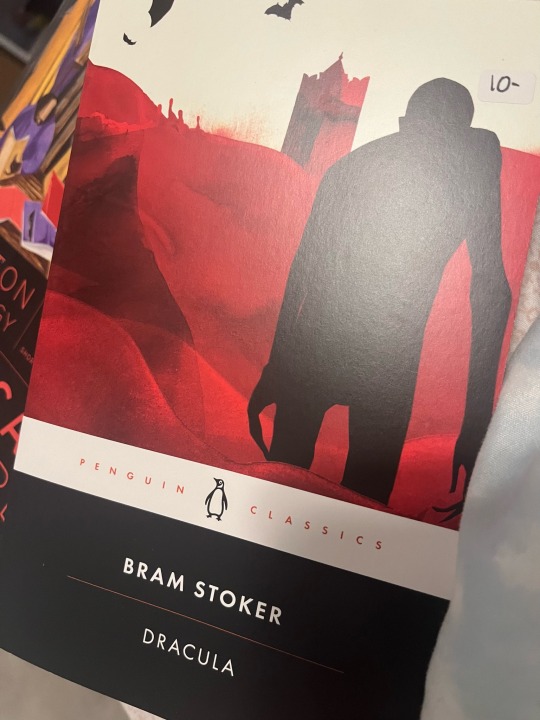
Feeling tired & unmotivated to do school assignments.
Going to read Dracula, since it seems like a fairly easy read compared to war & peace (my current read)
#book blog#book recs#booklr#dark academia#light academia#book photography#book review#classic literature#french literature#book recs classic#american literature#books & libraries#austrian literature#russian literature#english literature#old books#book quotations#books and reading#book quotes#bookworm#study aesthetic#dracula#study blog#student#studyblr#studyspo#study motivation#studying#student life#writer stuff
50 notes
·
View notes
Text

#girl blogger#girlhood#this is what makes us girls#we were girls together#girl interrupted#just girly things#this is a girlblog#ai girl#female hysteria#female insanity#it girl#girlblogging#hell is a teenage girl#tumblr girls#rachel sennott#70s fashion#french new wave#female rage#fleabag#female manipulator#female writers#femcel#letterboxd#movie review#movies#film#ayo edebiri#dark humor#humor#frida khalo
35 notes
·
View notes
Text

Prada Homme
#prada fall winter 24 review#parisian style#parisian vibe#parisian homme#essential homme#parisian mood#lovefrenchisbetter#french style#prada#miuccia prada
83 notes
·
View notes